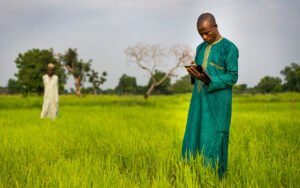Agricultural microinsurance is a type of insurance designed to help smallholder farmers protect their farms from risks that could harm their business. Extreme weather, pests, diseases, and market changes are just some of the things that smallholder farmers face daily. These risks can lead to crop failure, animal death, and many financial problems. Agricultural microinsurance aims to reduce these risks by providing farmers with a safety net that allows them to absorb potential losses and maintain their livelihoods. Agricultural microinsurance is important for food security and rural growth because it focuses on the specific needs of smallholder farmers.
1. The Need for Agricultural Microinsurance
Smallholder farmers in developing countries are at risk and that is why they need agricultural microinsurance. For many smallholder farmers, agriculture is their main source of income and they do not have a financial safety net. When natural events such as drought or flooding occur, they can lose a lot of money and are unable to provide for their families. Small farmers often cannot afford or obtain traditional insurance because the rates are too high and the application process is too difficult. Agricultural microinsurance fills this gap, providing small farmers with affordable insurance that is tailored to their needs.
2. How Farmer Microinsurance Works
Agricultural microinsurance typically follows plans that are designed to make things as simple and inexpensive as possible. Farmers pay low premiums, depending on how much coverage they want and how much money they make. Coverage options often include protection against crop failures due to severe weather, insect infestations, and other agricultural risks. If a covered loss occurs, farmers can receive financing to help them get back on their feet and continue growing. The claims process should be simple so that farmers can access benefits quickly and with as little hassle as possible.
3. Affordable for Small Farmers
A key objective of agricultural microinsurance is to help small farmers obtain insurance at a price they can afford. Premiums are often kept low to avoid putting too much pressure on farmers’ already tight budgets. Insurance companies are often coming up with new pricing methods. One example is index-based insurance, where payouts are based on specific weather conditions or crop yields rather than individual ratings. This approach reduces costs and speeds up the claims process, making it easier for small-scale farmers to obtain insurance.
4. Index Insurance Overview
Index-based insurance is a new way of working that is becoming increasingly popular in agricultural microinsurance. While traditional insurance requires a detailed assessment of each loss, index-based insurance uses a fixed number, such as rainfall or temperature, to determine the payout. For example, if certain conditions are met in a region and a drought occurs, farmers in that region are paid immediately. This approach makes it easier to file claims, reduces administrative costs, and ensures that payments are made on time, all of which are important for farmers who are currently struggling for money.
5. Why Agricultural Microinsurance is a Good Idea
Agricultural microinsurance has many benefits and can improve the lives of smallholder farmers. First, it protects farmers financially, allowing them to buy seeds, fertilizers, and other inputs without fear of losing everything if something bad happens. Second, it allows people to better manage risk, as farmers are more likely to adopt new tools and farming methods if they know they are protected by insurance. Third, agricultural microinsurance makes it easier to obtain loans, as banks are more likely to lend to insured farmers because they know their investments are safe.
6. Make Sure You Have Enough Food
Agricultural microinsurance is a very important part of ensuring food security because it provides a safety net for small-scale farms. When farmers are protected from risk, they are more likely to maintain stable production levels and reinvest capital in their farms. This stability not only helps individual farms but also makes local and national food systems more stable as a whole. Microinsurance can help small farmers where agriculture is the main source of income. This can reduce food insecurity and improve the health of communities.
7. Challenges Faced by Agricultural Microinsurance
Agricultural microinsurance has many benefits, but some issues make it less useful. Educating farmers about microinsurance products and their benefits is a major issue that needs to be addressed. Many small farmers may not know much about insurance or have misconceptions about its effectiveness. In addition, problems can arise if interest rates are too high, especially when financial resources are tight. Furthermore, the rules and regulations in many countries may not fully support the growth and development of microinsurance products, which will limit their reach and effectiveness.
Conclusion
Agricultural microinsurance is an important way to protect smallholder farmers from the many risks they face every day. By making insurance more affordable and promoting financial stability, farmers can invest in their businesses and contribute to the food security of their communities. Despite its challenges, crop microinsurance has great potential to change the way agriculture is produced. Agricultural microinsurance can help smallholder farmers engage with their communities, develop new technologies, and continue to learn how to thrive in a world that has become unstable. Going forward, it is important to support and invest in microinsurance programs to help smallholder farmers and provide them with the tools and resources they need to build strong and sustainable agricultural systems.
FAQs
1. What is farmer microinsurance?
Agricultural microinsurance is a special type of insurance designed to protect small farmers from hazards such as crop failure, livestock loss, and natural disasters. It offers insurance at a price that fits the needs and budgets of low-income farmers.
2. What is the difference between agricultural microinsurance and general insurance?
Traditional insurance tends to have higher rates and more complex policies. Agricultural microinsurance, on the other hand, aims to be low-cost and easy to understand. It is designed to help small farmers by providing them with clear and accessible coverage options.
3. Who can get agricultural microinsurance?
Small farmers are often eligible for agricultural microinsurance. This is usually based on their land area or income. There are many programs aimed at helping farmers in rural areas of poor countries.
4. What types of insurance does agricultural microinsurance offer?
Coverage options vary, but most offer protection against natural disasters (such as floods and droughts), insect damage, and crop failure. Some policies may also cover livestock losses or provide additional benefits, such as financial services.
5. How are micro-insurance rates for agriculture determined?
Premiums are usually kept low to make them affordable for smallholders. They may be based on factors such as crops grown, acreage, and required coverage. Some systems may also use an index-based model for pricing.




